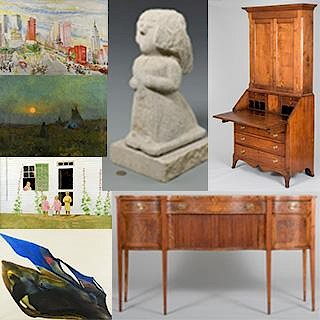Gilbert Gaul O/C, Indian Encampment
Lot 176
About Seller
Case Auctions
4310 Papermill Dr. NW
Knoxville, TN 37909
United States
Case Auctions is based in Knoxville, Tennessee, where our gallery is located, with satellite offices in Nashville, Tennessee and Kingsport, TN – but our reach is worldwide. Established in 2005, we conduct cataloged auctions of investment-quality art and antiques under the stewardship of knowledgeabl...Read more
Categories
Estimate:
$6,000 - $8,000
Sold for
$9,200
Absentee vs Live bid
Two ways to bid:
- Leave a max absentee bid and the platform will bid on your behalf up to your maximum bid during the live auction.
- Bid live during the auction and your bids will be submitted real-time to the auctioneer.
Bid Increments
| Price | Bid Increment |
|---|---|
| $0 | $10 |
| $100 | $25 |
| $500 | $50 |
| $1,000 | $100 |
| $3,000 | $200 |
| $5,000 | $500 |
| $10,000 | $1,000 |
| $20,000 | $2,000 |
| $50,000 | $5,000 |
| $100,000 | $10,000 |
About Auction
By Case Auctions
Jan 21, 2017 - Jan 22, 2017
Set Reminder
2017-01-21 09:00:00
2017-01-22 09:00:00
America/New_York
Bidsquare
Bidsquare : Winter Fine Art and Antiques Auction
https://www.bidsquare.com/auctions/case-antiques/winter-fine-art-and-antiques-auction-2050
Case Auctions bid@caseantiques.com
Case Auctions bid@caseantiques.com
- Lot Description
Gilbert Gaul (New York/Tennessee/New Jersey, 1855-1919) oil on canvas painting titled "Indian Camp" depicting the silhouette of a lone figure and two Native American teepees in the dim light of the setting sun. Signed "Gaul" lower left. Cumberland Art Conservation, Nashville, TN label, en verso. Later giltwood frame with beaded rabbet edge. Sight - 17 1/2" H x 23 1/2" W. Framed - 23 1/2" H x 29 3/8" W. Late 19th century. Biography (courtesy The Johnson Collection): New Jersey born artist Gilbert Gaul studied art with Lemuel E. Wilmarth at the school of the National Academy of Design from 1872 to 1876, and privately with the noted genre painter, J. G. Brown. He continued his training at the Art Students League during 1875 and 1876. Gaul first exhibited his work at the National Academy in 1877. In 1881, he inherited a farm in Van Buren County, Tennessee, from his mother_s family, and lived there four years to fulfill terms of the bequest. In 1885, he returned to New York though he also continued to spend time at the farm in Tennessee. Gaul gained acclaim for his illustration art and portrayals of Civil War scenes. He became a regular exhibitor at the National Academy annuals between 1877 and 1902; in 1882, he was accorded the status of full academician--the youngest artist to attain the honor. He exhibited at the 1889 Paris Exposition; the 1893 World Columbian Exposition in Chicago; and the 1902 Pan-American Exposition in Buffalo, where he was awarded medals. In 1876 Gaul made his first trip to the American West, an area for which he developed a particular affinity. He made numerous western trips in subsequent years, photographing and rendering scenes of Native Americans and the frontier, which he would later work up into paintings in his studios in New York or Tennessee. In 1890, he worked for the United States census on reservations in North Dakota. He also visited Mexico, the West Indies, Panama, and Nicaragua. An account of his travels was published in Century Magazine in 1892. In 1904, he returned to Tennessee and settled in Nashville. The decreasing interest in Civil War subjects resulted in financial hardship for Gaul. He gave private art lessons, and taught at the Watkins Institute, Nashville, and at Cumberland Female College, in McMinnville. He also spent time in Charleston, South Carolina. By 1910, he had moved to Ridgefield, New Jersey, where he continued to paint and live out his remaining years. Provenance: The living estate of Dr. and Mrs. Benjamin H. Caldwell, Nashville, TN. (Higher-resolution photos are available at www.caseantiques.com)Lined, with overall surface craquelure and several spots of inpainting. Left side of canvas is not completely covered by rabbet edge. Cumberland Art Conservation label records treatment in June/July 2003, with details listed on label (refer to photo). Blacklight reveals scattered craquelure infill painting, along with a 3" line of inpaint near left edge and a 3" H-shaped area of inpaint to center, 1 1/2" p-shaped area of inpaint to center of right side. Small area of tiny paint flakes in a line at upper edge.
Condition
- Shipping Info
-
Buyer Pays Shipping Cost – Buyers are responsible for making shipping arrangements through our recommended shippers or a shipper of their choice. For shipping estimates, contact these shippers with the lot number(s) or a shipper of your choice. Our recommended shippers follow:
- Package Manager of Knoxville, 865-584-3000, info@packagemanager.net (The Manager is Gwynn)
- The UPS Store of Northshore Knoxville, 865-951-2499, store6461@theupsstore.com (The Manager is Jonathan)
- The UPS Store of Lenoir City, 865-988-5526, auction4526@theupsstore.com (The Manager is John)
- The UPS Store of Downtown Knoxville, 865-584-0081, store2630@theupsstore.com (The Manager is Nathan).
-
- Buyer's Premium



 EUR
EUR CAD
CAD AUD
AUD GBP
GBP MXN
MXN HKD
HKD CNY
CNY MYR
MYR SEK
SEK SGD
SGD CHF
CHF THB
THB




















